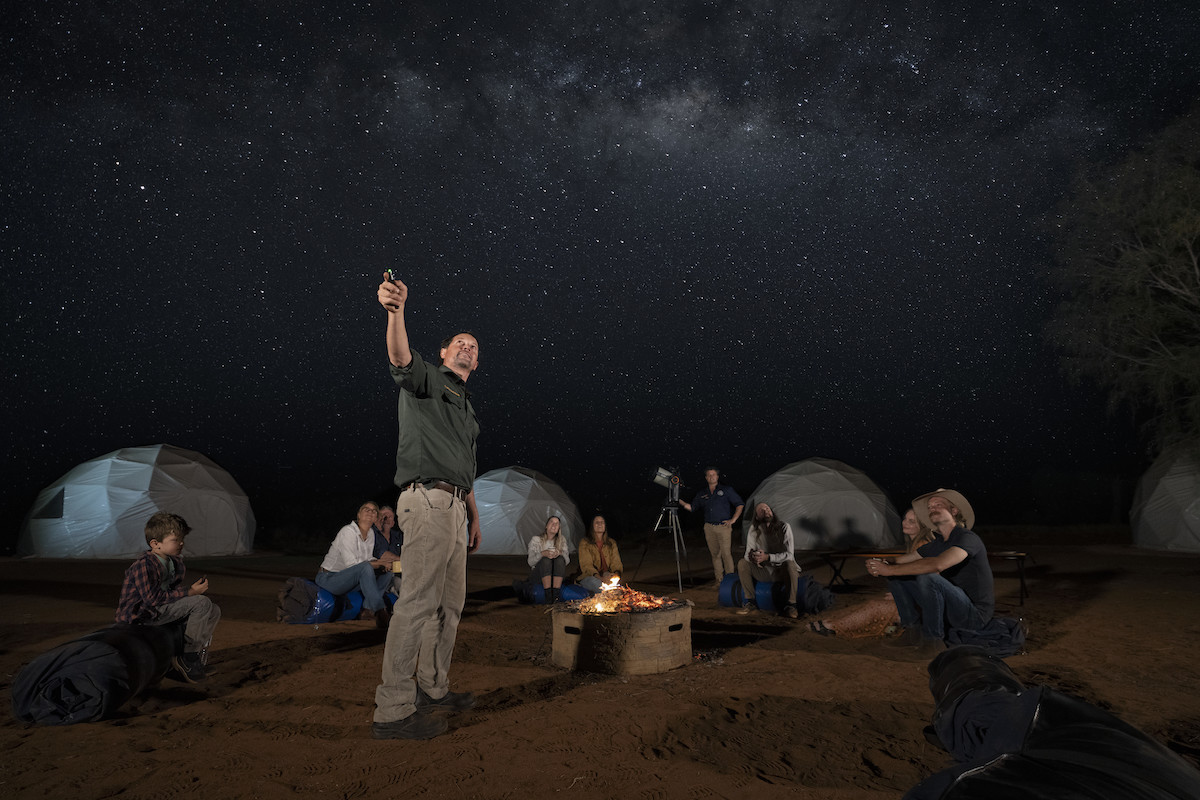
Central Australia’s Earth Sanctuary Observatory near Alice Springs offers overnight tours of the cosmos after which stargazers can retire to comfortable eco-domes. Photo courtesy of NT/Tourism Australia
By Tom Adkinson
Ancient Babylonians and Greeks peered into a dark night sky and started naming constellations. Copernicus observed enough in cloudless night skies to move Earth from the center of the universe to its rightful place orbiting the Sun. Slaves on the Underground Railroad depended on the North Star Polaris to guide them to freedom.
You and I still can gaze at stars, but few of us see the sky the same way people did only a few centuries past, much less millennia ago.
Modern society’s desire to light up the night – whether for safety, commerce or entertainment – has compromised the view.
Out of the mouths of babes
Proof of that for St. Louis resident Amanda Doyle came last year when her daughter, Molly, then 8 years old, posed a telling question. Doyle’s family had rented a cabin in the Mark Twain National Forest almost a hundred miles from St. Louis.
“We’re outside a lot at home and enjoy the night sky, but on our first night in the cabin, Molly looked up from the deck and asked, ‘Why do they have more stars out here in the country than we do at home?’”
Later during that vacation, Doyle said Molly found constellations she’d seen only in books and even found the Dippers and Orion’s Belt.
“Her context for finding the Big Dipper was from a song tied to the Underground Railroad, ‘Follow the Drinking Gourd.’ Molly already had heard about following the stars in school,” Doyle said.
A need for wonderment and contemplation
Light pollution means that 80 percent of North Americans cannot see the Milky Way, even on the clearest winter night, according to the National Park Service’s natural sounds and night skies division.
“With the loss of dark night sky views, the ancestral stories of celestial phenomena that so richly express our connection to these orbiting bodies are all but forgotten. And this is more than a matter of nostalgia. Humans need opportunities for wonderment and contemplation of the universe,” said NPS scientist Dan Duriscoe in a news release about “The New World Atlas of Artificial Sky Brightness.”
Despite population growth and increasing artificial lighting, there’s an organization whose goal is securing more opportunities to see the skies of your ancestors. It’s the International Dark-Sky Association (IDA), a nonprofit created in 1988.
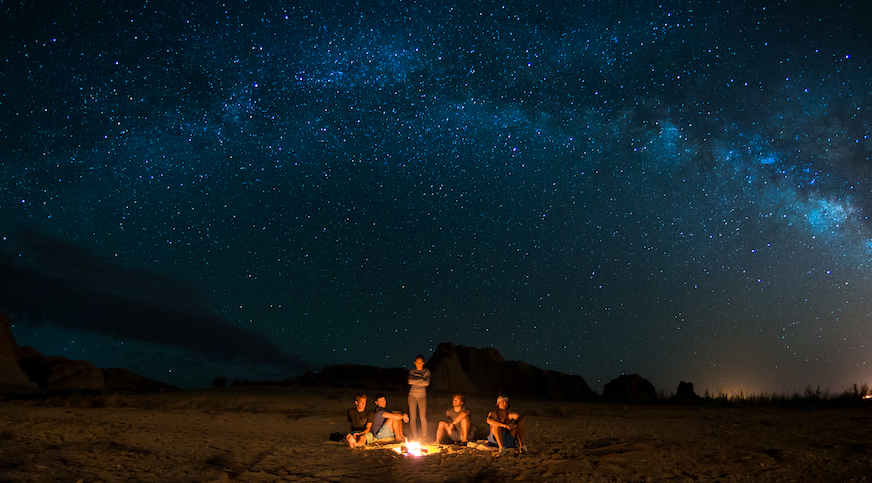
At Lake Powell near Page, Arizona a campfire offers a perfect opportunity for stargazing. Photo by An Pham
Earning a dark sky rating takes work
When you start scouting for a stargazing location, an IDA endorsement is like a Good Housekeeping Seal of Approval. The IDA has strict criteria to designate a dark sky park, community, reserve, sanctuary or urban night sky place.
It takes considerable work to earn an IDA rating. Among newer sites is the Central Idaho Dark Sky Reserve covering 1,416 square miles, with much of it in the Sawtooth National Recreation Area. In 2017, it became the first gold-tier dark sky reserve in the U.S.
“We started rallying around the idea in the early 2000s,” said Carol Cole, president of the Idaho Dark Sky Alliance, a volunteer organization. She said some of the early inspiration came from Dr. Stephen Pauley, a physician who wanted to protect the night sky. He became known as Dr. Dark.
Serious work began in 2015, Cole said, and required cooperation among three towns (Ketchum, Sun Valley and Stanley), two counties, parts of three other counties and the U.S. Forest Service.
“We realized we had a natural resource,” Cole said, recalling the work to encourage appropriate lighting fixtures (ones that shine only when necessary, ones that direct light appropriately, ones that minimize “skyglow”) and to educate and enlist municipal governments, homeowners and contractors in the cause.
Star parties are occasions for awe and education
Continuing education of visitors is another aspect of IDA certification, so count on hearing about light pollution mitigation at any stargazing program you attend, whether in a park or at a private resort.
“Star party” is the generic term for dark sky events, which often feature academic or amateur astronomers who provide commentary and shared peeks through their telescopes.
“Our preserve offers jaw-dropping views that are inspirational. People who haven’t seen the Milky Way or the expansive night sky are simply blown away,” Cole said.
Looking up while down south
Of course, prime locations to view the night sky are south of the equator, too, where there are constellations new to travelers from the northern hemisphere. Of the 88 constellations astronomers recognize, 32 are in the southern hemisphere.
The most famous is Crux, more commonly called the Southern Cross. This five-star constellation is so prominent and culturally significant that it is integral to the flags of Australia, New Zealand, Brazil, Samoa and Papua New Guinea.
Several IDS-certified sites are in South America, Africa and the South Pacific, and New Zealand is seeking a dark sky rating for the whole country.
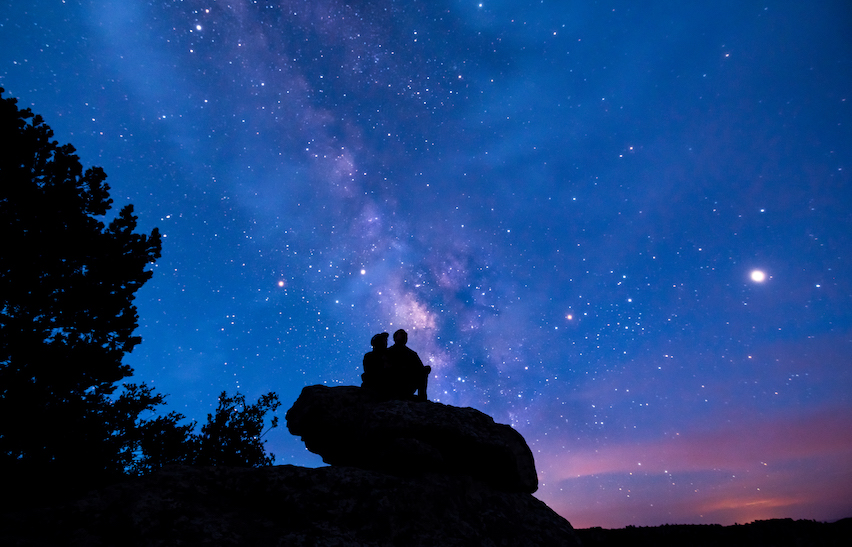
A moment of quiet contemplation at the Chiricahua National Monument in Wilcox, Arizona, can put worldly concerns into perspective. Photo by An Pham
Just what is the Milky Way?
When you first see the Milky Way, it is difficult to comprehend exactly what you are seeing. Ancient Babylonians saw the Milky Way, and an epic creation poem from their time said it was the severed tail of a dragon goddess slain by another god.
Modern science understands that it is a galaxy, a huge conglomeration of stars, dust and gas. Earth itself is inside the Milky Way, and if you could view it from the top or bottom, you’d see a spinning pinwheel. In one of the pinwheel’s arms is our Sun, one tiny spot of light among the 100 to 400 billion stars in the Milky Way.
Yes, 100 billion is the low-end estimate of how many stars are in the Milky Way.
Ponder that number while realizing that the Milky Way – as big as it is – is far from the only galaxy in the cosmos. One scholarly calculation estimates there are two trillion galaxies.
That’s enough to make your head hurt – or inspire you to look as deeply as you can into the night sky. Remember, however, that only about 6,000 stars are visible from Earth.
A moon-like surface here on Earth
Craters of the Moon National Monument and Preserve, located east of the Central Idaho Dark Sky Preserve, is another popular dark sky destination. It acquired International Dark Sky Park status in 2017.
Its moon-like, volcanic terrain – which President Calvin Coolidge described as “a weird and scenic landscape, peculiar to itself” when dedicating the monument – seems an especially appropriate place to look into the heavens. Apollo astronauts trained here, trying to approximate what they would encounter on the moon.
National Park Service rangers offer nighttime programs, especially in the summer, and volunteers from the Idaho Falls Astronomical Society sometimes set up telescopes to give you closer looks at stars and planets.
“Looking up into the stars helps remind me that I’m insignificant . . . and that’s OK,” says Sandra Gladish, director of interpretation and education at Craters of the Moon National Monument and Preserve. “The stars are out there, and that’s humbling.”
“Dark skies became more important as we started recognizing they were diminishing. Even though we are 90 miles from Idaho Falls or Twin Falls, their lights can affect us,” Gladish adds, noting that smoke from wildfires considerable distances away also can diminish dark sky views.
Photographing the night sky around the world
World-traveling photographer Kerrick James shoots all types of subjects out of his home base in Phoenix. But he has a special affinity for photographing the stars.
“I’ve been shooting the night sky since the days of film, back when I’d have all-night exposures,” James smiles, noting that some of his favorite locations are in the American West.
Among them are the Big Bend region of West Texas, Monument Valley on the Arizona-Utah border and southern Arizona near the border with Mexico. As you might expect, those areas and many others are prominent on the IDS and National Park Service maps of prime dark sky locations.
For photographic reasons, James especially likes the drier months in the western U.S. – late spring into early summer and again in late autumn.
“The Southwest really dries out. When the conditions are right, you can see the galactic core of the Milky Way,” James said.
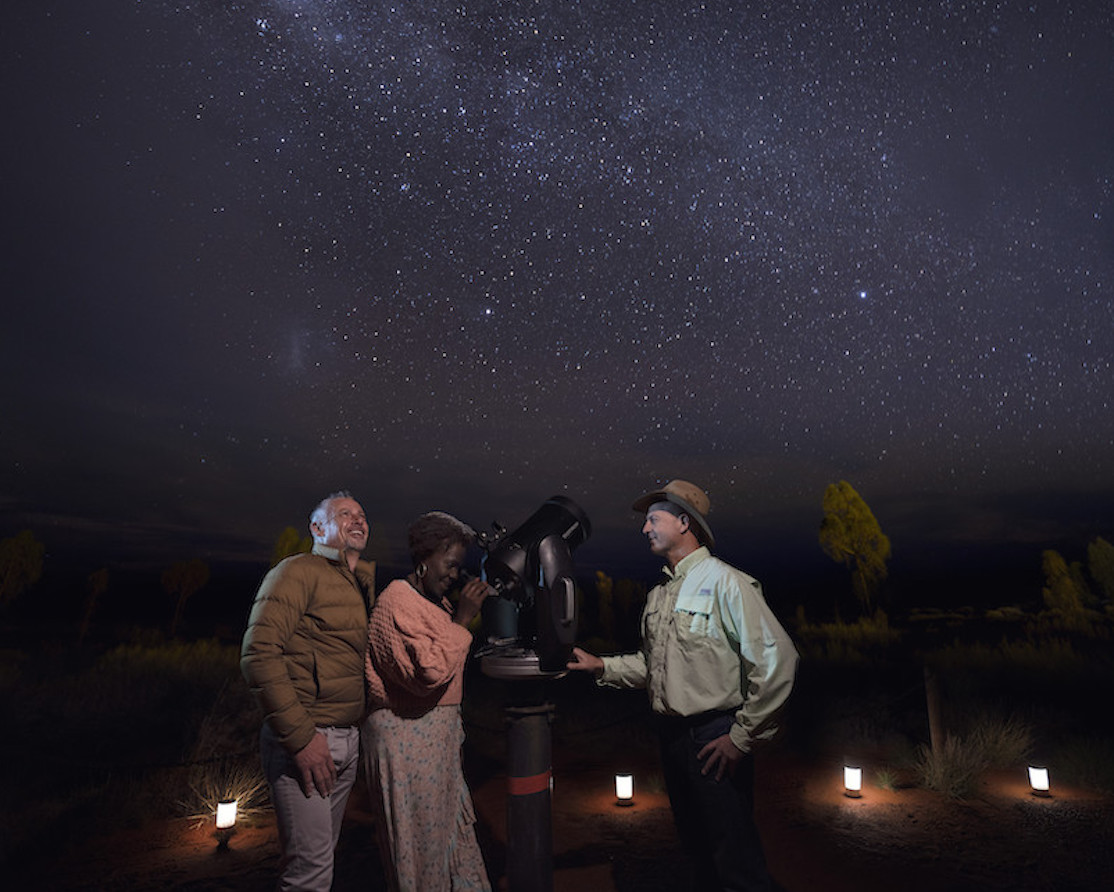
The Ayers Rock Resort in Australia’s Northern Territory combines stargazing with sunset drinks, canapés and a three-course dinner. An amateur astronomer insures that visitors know which constellations they’re dining beneath. Photo by Shaana McNaugh
Serious amateur photographers can do well
Although James is a professional photographer and has the images to prove it, he knows serious amateur photographers can do well too.
“There is a burgeoning interest in photographing the night sky. If you have a relatively new camera with a sensitive sensor, a more powerful image processor and a fairly fast lens, you’re less likely to get star movement,” he says. “We have pushed the envelope of artistic quality of night sky photography.”
James doesn’t limit his search for night sky images to North America. “I’m always looking for places to shoot the Milky Way over iconic locations. I got one unexpectedly in 2022 in Switzerland with the Eiger in the foreground,” he beams.
Dark sky sites may be closer than you think
You don’t necessarily have to travel great distances to witness the beauty of a dark night sky. The world map of almost 200 IDS-certified locations, which the IDS notes is not designed to be a comprehensive list, shows dark sky targets scattered across the U.S., Canada, Great Britain, Northern Europe and Central Europe. The National Park Service identifies even more good locations.
One site you might not expect is in the hills of north-central Tennessee east of Nashville and west of Knoxville. It is surprisingly isolated – and dark.
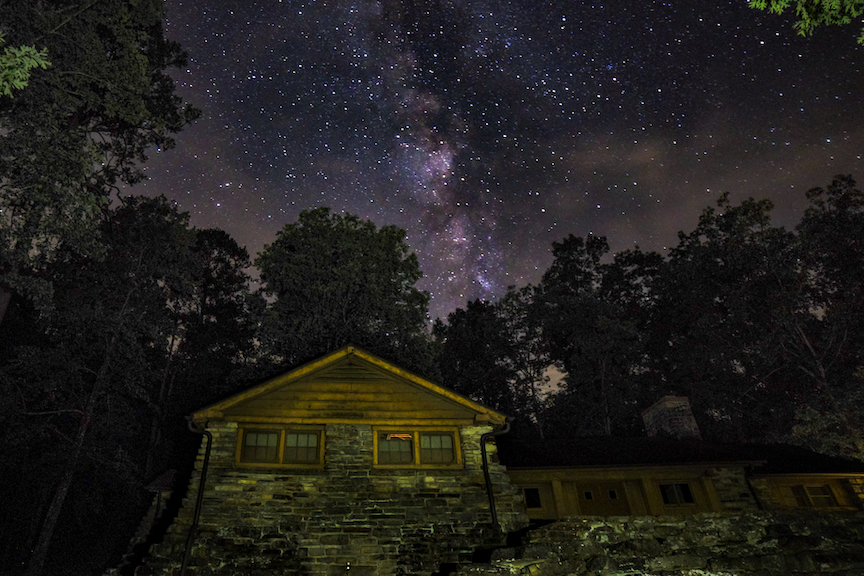
At the Pogue Creek State Natural Area in Tennessee’s Cumberland Mountains, the Milky Way fills the night sky above a Depression-era lodge built in 1937. Photo by Michael Hodge
It is Pogue Creek Canyon State Natural Area in the Cumberland Mountains and adjacent to Pickett Civilian Conservation Corps Memorial State Park. It received IDS rating as a silver-tier park in 2015.
“That was after four years of work that included a new business lighting program in Jamestown, about 12 miles from the park,” said ranger Michael Hodge.
Hodge says he tries to lead a monthly astronomy program in an 11-acre site in Pogue Creek Canyon. The site is open at other times for individual visitation, but linking up with Hodge has a special benefit.
That benefit is the Celestron C8 telescope, which Hodge said is a very popular amateur telescope.
Seeing the moons of Jupiter that Galileo saw
“Most people who come here never have seen anything through a telescope themselves. They’re blown away seeing the rings of Saturn, cloud belts on Jupiter or four of Jupiter’s moons, the moons Galileo saw 400 years ago,” Hodge said.
“Starting in May, we’ll see the Milky Way in the eastern sky, and by mid-summer, it goes horizon to horizon. People don’t expect that in Tennessee,” he said.
Hodge uses his programs to explain how Pogue Creek Canyon got its dark sky status, the nature of light pollution and the importance of the night sky as a cultural resource.
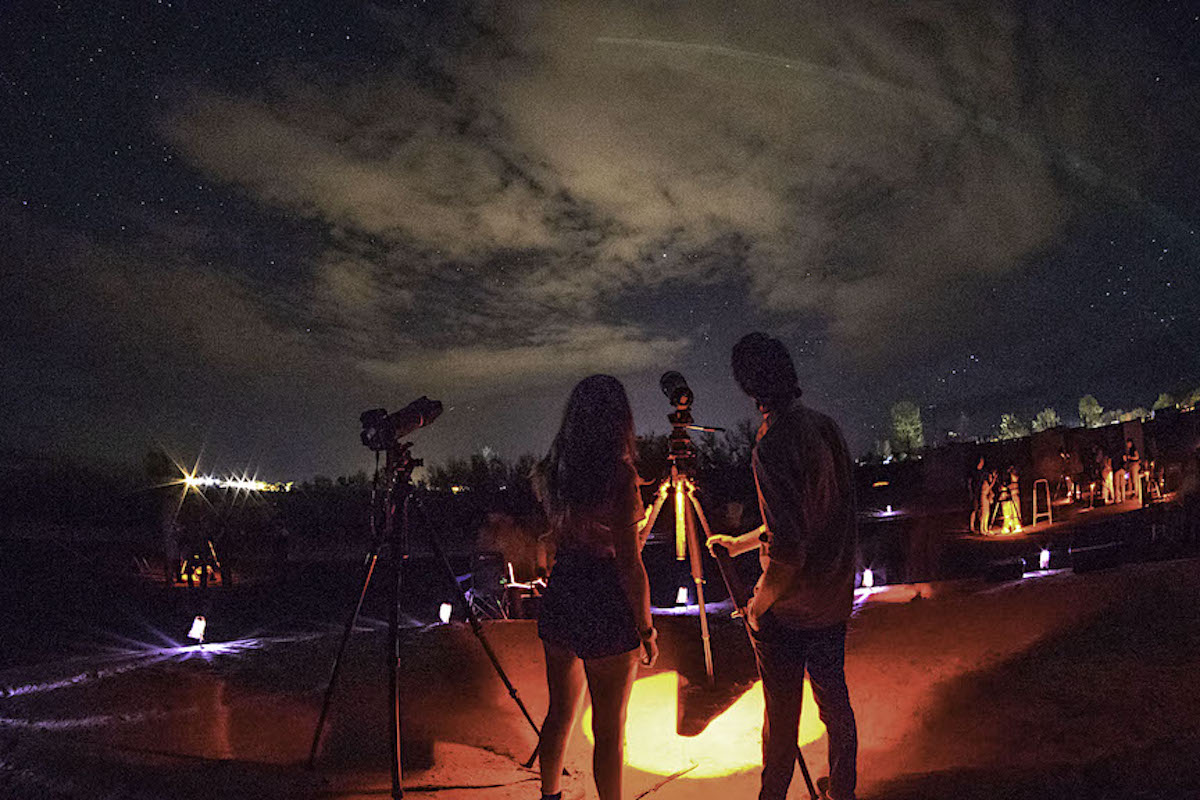
Star Party at Wahweap Beach, Glen Canyon National Recreation Area, Page, Arizona. Photo by Kerrick James
Learn the phases of the moon
Regardless of whether you meet a program leader such as Hodge or a National Park Service ranger, all night sky advocates encourage you to seek opportunities to appreciate what’s right over your head.
Here’s a tip for new stargazers: Give yourself a head start by recognizing the phases of the moon. Regardless of where you are, the sky is darkest on a new moon when no sunshine reflects off the moon into the sky you want to observe.
Kelly Young, a school administrator in Vail, Colorado, can attest to the importance of good timing. She recalls a family camping trip that made memories for a lifetime.
“We had a beautiful campsite right next to the Colorado River. The only sound was the rushing river. We woke the sleepy kids at 3 a.m. and re-settled everyone on the sandy beach. We had timed the Perseid meteor shower just right.
“There were millions of stars with several falling stars every minute. One of the best nights of camping ever! We truly understood the ‘rainin’ fire from the sky’ lyric from John Denver’s ‘Rocky Mountain High,’” Young remembers.![]()
East-West News Service contributor Tom Adkinson lives in Nashville, TN. He has enjoyed dramatic night skies in Texas’ Big Bend National Park, the Boundary Waters Canoe Area in Minnesota and Philmont Scout Ranch in New Mexico.

